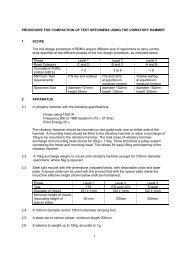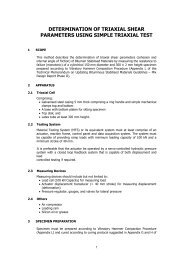Updating Bituminous Stabilized Materials Guidelines Mix Design Report Phase II
Moisture Sensitivity: Part II (Validation) - Asphalt Academy
Moisture Sensitivity: Part II (Validation) - Asphalt Academy
- No tags were found...
You also want an ePaper? Increase the reach of your titles
YUMPU automatically turns print PDFs into web optimized ePapers that Google loves.
in the specimen, which strengthens the mix. The specimen then covered with a plastic bag and<br />
sealed for two x 24 hours intervals so that no further moisture removed from the specimen at a<br />
temperature of 40ºC. This accelerated curing procedure is equivalent to 7 to 14 days in the field,<br />
(Malubila, 2005).<br />
2.2.3 Cutting of specimens<br />
Following curing and cooling to ambient temperature, the specimens are ready for cutting. The<br />
cutting processes need attention and care, to minimise any damage to the specimen. The<br />
cutting of BSMs with additional of active filler is easier than BSMs without active filler. The latter<br />
mix is less cohesive and rather brittle, so spalling of the aggregate occurs if the wrong cutting<br />
technique is applied. The cutting of the BSMs without active filler is made easier by reducing the<br />
specimen temperatures in a fridge to below freezing. There are two types of blades that are<br />
used for cutting of the specimen. The slotted blades are for cutting the specimen into slices of<br />
90mm. The continuous blade is more for trimming and delicate cutting.<br />
The dimensions of the specimen after compaction are 300mm tall with a diameter of 150mm.<br />
Each specimen is cut into slices of 90mm high. However, due to difficulties in cutting 300mm<br />
specimen, an alternative measures taken to compact two layers of 50mm and later trim the<br />
specimen to size indicated in Figure J.11 and Figure J.12.<br />
Figure J.11: The top view of the specimen before and plan for cutting<br />
The next step is to remove the sides of the specimen, so it can fit in the MMLS3 set-up. The<br />
diameter of the specimen is 150 mm and the sides of the specimen cut off to a size of 110mm,<br />
as illustrated in Figure J.12.<br />
10












